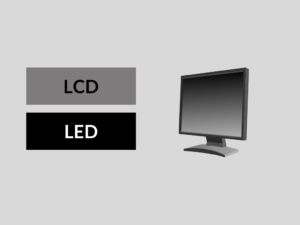AMOLED vs LCD: Understanding the Differences
Welcome to this comprehensive article that aims to shed light on the key differences between AMOLED and LCD display technologies. As we dive deep into this subject, we will explore what AMOLED and LCD are, their uses, and eventually compare the two in terms of various factors.
What is AMOLED?
AMOLED, or Active-Matrix Organic Light-Emitting Diode, is a display technology that uses organic compounds to emit light when an electric current passes through them. Each pixel in an AMOLED display consists of organic compounds that produce their own light, resulting in vibrant colors and deep blacks.
Examples of AMOLED
Some popular examples of AMOLED displays include Samsung’s Super AMOLED, Super AMOLED Plus, and Super Retina XDR used in iPhones.
Uses of AMOLED
AMOLED panels find applications in a wide range of devices, including smartphones, tablets, smartwatches, and televisions. The ability to provide deep blacks, high contrast ratios, and vibrant colors makes AMOLED attractive for various multimedia-oriented devices.
What is LCD?
On the other hand, LCD, or Liquid Crystal Display, is a display technology that uses liquid crystals to manipulate light. Unlike AMOLED, LCD doesn’t emit light on its own. Instead, it relies on a backlight source to illuminate the pixels.
Examples of LCD
Some well-known examples of LCD displays include those used in iPhones, iPads, and most standard televisions.
Uses of LCD
LCDs are widely used in devices such as smartphones, tablets, computer monitors, televisions, and digital signage due to their versatility. They offer good image quality, energy efficiency, and affordability compared to other display technologies.
Differences between AMOLED and LCD
| Difference Area | AMOLED | LCD |
|---|---|---|
| Black Levels | AMOLED displays achieve true blacks as each pixel produces its own light, turning off pixels individually. | LCD panels struggle to display true blacks due to the presence of a backlight that always emits light. |
| Color Accuracy | AMOLED displays offer more vibrant and saturated colors, sometimes oversaturating certain shades. | LCD panels provide accurate color reproduction with natural shades. |
| Contrast Ratio | AMOLED displays have significantly higher contrast ratios, resulting in better differentiation between light and dark areas. | LCD panels struggle to achieve high contrast ratios as they rely on the backlight’s brightness levels. |
| Viewing Angles | AMOLED displays offer excellent viewing angles with consistent image quality from various angles. | LCD panels experience color shifting and loss of image quality when viewed from extreme angles. |
| Power Efficiency | AMOLED displays consume less power as each pixel emits light individually, allowing black pixels to be turned off entirely. | LCD panels use a constant backlight, consuming more power even when displaying darker content. |
| Response Time | AMOLED displays have faster response times, resulting in smoother motion and reduced motion blur. | LCD panels have slower response times, leading to motion blur and ghosting in fast-paced content. |
| Screen Refresh Rate | AMOLED displays can achieve higher refresh rates, providing smoother visuals and improved gaming experience. | LCD panels usually have lower refresh rates, resulting in a slightly less smooth visual experience. |
| Display Lifespan | AMOLED displays may experience burn-in over time, causing certain static elements to be permanently visible. | LCD panels do not suffer from burn-in and offer longer lifespans. |
| Thickness | AMOLED displays can be thinner and lighter since they do not require a separate backlight layer. | LCD panels are generally thicker and heavier due to the presence of a backlight. |
| Cost | AMOLED displays tend to be more expensive to produce, making devices equipped with them relatively costlier. | LCD panels are more cost-effective, making devices using them more affordable. |
Conclusion:
In summary, both AMOLED and LCD display technologies have their own strengths and weaknesses. AMOLED offers deeper blacks, vibrant colors, better contrast ratios, and power efficiency. On the other hand, LCD provides accurate color reproduction, excellent viewing angles, longer lifespans, and affordability. The choice between these two display technologies ultimately depends on individual preferences, specific device requirements, and budget constraints.
People Also Ask:
Q: Which display technology is better, AMOLED or LCD?
A: The choice between AMOLED and LCD depends on the desired features and budget. AMOLED offers better black levels, vibrant colors, and contrast ratios, but it comes at a higher cost. LCD, on the other hand, provides accurate color reproduction, excellent viewing angles, longer lifespans, and affordability.
Q: Can AMOLED displays suffer from burn-in?
A: Yes, AMOLED displays can experience burn-in over time. Burn-in is a phenomenon where certain static elements on the screen, such as navigation buttons or status icons, may leave a permanent ghost image. However, manufacturers have implemented measures to minimize the risk of burn-in.
Q: Are AMOLED displays more power-efficient than LCD?
A: Yes, AMOLED displays are generally more power-efficient compared to LCD. Since AMOLED pixels emit their own light, black pixels can be completely turned off, resulting in lower power consumption. LCD panels require a constant backlight, which consumes more power even when displaying darker content.
Q: Can LCD displays achieve higher refresh rates like AMOLED?
A: While it’s possible for LCD displays to achieve higher refresh rates, most standard LCD panels have lower refresh rates compared to AMOLED displays. However, high-end gaming monitors using LCD panels can offer refresh rates on par with AMOLED displays.
Q: Are AMOLED displays more expensive than LCD?
A: Yes, AMOLED displays tend to be more expensive to produce compared to LCD panels. As a result, devices equipped with AMOLED displays usually carry a higher price tag. LCD panels are more cost-effective, making devices using them more affordable for a broader range of consumers.


